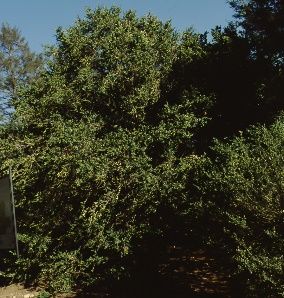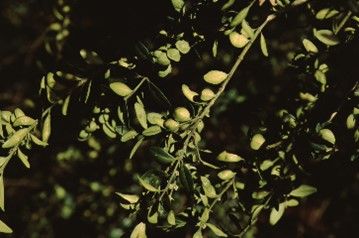Introduction
Long a tradition in colonial landscapes, boxwood is a fine textured plant familiar to most gardeners and non-gardeners alike. Eventually reaching 6 to 8feet-tall (old specimens can be much taller), boxwood grows slowly into a billowing mound of soft foliage. Flowers are borne in the leaf axils and are barely noticeable to the eye, but they have a distinctive aroma that irritates some people.

Credit: Edward F. Gilman, UF/IFAS

Credit: Edward F. Gilman, UF/IFAS

Credit: Edward F. Gilman, UF/IFAS
General Information
Scientific name: Buxus sempervirens
Pronunciation: BUCK-sus sem-pur-VYE-renz
Common name(s): common boxwood, common box, American boxwood
Family: Buxaceae
Plant type: shrub
USDA hardiness zones: 6 through 8 (Figure 4)
Planting month for zone 7: year round
Planting month for zone 8: year round
Origin: not native to North America
Invasive potential: not known to be invasive
Uses: border; edging; foundation; superior hedge
Availability: generally available in many areas within its hardiness range

Credit: undefined
Description
Height: 8 to 20 feet
Spread: 10 to 15 feet
Plant habit: round
Plant density: dense
Growth rate: slow
Texture: fine
Foliage
Leaf arrangement: opposite/subopposite
Leaf type: simple
Leaf margin: entire
Leaf shape: oblong; ovate
Leaf venation: none, or difficult to see
Leaf type and persistence: evergreen
Leaf blade length: less than 2 inches
Leaf color: green
Fall color: no fall color change
Fall characteristic: not showy
Flower
Flower color: green
Flower characteristic: spring flowering
Fruit
Fruit shape: irregular
Fruit length: less than 1/2 inch
Fruit cover: dry or hard
Fruit color: unknown
Fruit characteristic: inconspicuous and not showy
Trunk and Branches
Trunk/bark/branches: typically multi-trunked or clumping stems; not particularly showy
Current year stem/twig color: green
Current year stem/twig thickness: thin
Culture
Light requirement: plant grows in part shade/part sun
Soil tolerances: slightly alkaline; clay; sand; acidic; loam
Drought tolerance: moderate
Soil salt tolerances: poor
Plant spacing: 24 to 36 inches
Other
Roots: usually not a problem
Winter interest: no special winter interest
Outstanding plant: not particularly outstanding
Pest resistance: long-term health usually not affected by pests
Use and Management
Boxwood makes a beautiful clipped hedge, lending a formal air to any landscape. It looks best when located along a foundation or as a border along a walk or path. Plant it far enough away from the walk unless you plan on regular clipping to keep the walk clear. Locating it several feet away will keep the foliage away from the walk for several years. Its distinctive form and rich, dark color make it less appropriate for mass planting or for specimen planting. It can be clipped into and maintained in virtually any shape. Unpruned plants maintain a more-or-less globe shape.
A partially shaded or sunny spot is best suited for boxwood. It enjoys a clay or loamy soil with a reasonable amount of organic matter. Sandy soils are usually not suited for boxwood unless irrigation can be provided, or plants are protected from all-day sun. Soil borne nematodes also enjoy boxwood roots in sandy soils.
Many cultivars exist with various leaf forms and variegation, plant shapes and sizes.
Pests and Diseases
Boxwood leaf miner is the traditional and perennial pest of boxwood. Infestation rarely kills plants, but foliage can be marred and severely discolored if the infestation is serious. Soil nematodes can be especially troublesome in sandy soils. Roots rot if soil is kept too wet.